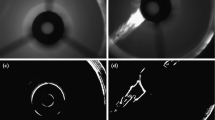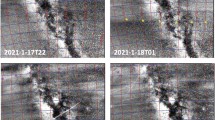Abstract
The solar corona is the outer layer of the Sun’s atmosphere. The brightness of the solar corona is a million times lower than that of the solar disk. The Earth’s sky brightness itself is high enough to cover the coronal signal during ground-based observations. For this reason, the study of sky characteristics plays a fundamental role in observing the solar corona. To date, the only place with the sky characteristics that allow continuous coronagraphic measurements from Earth is at the MLO (Mauna Loa Observatory; Hawaii, \({\approx }\,3400\mathrm{\,m}\) above sea level). This paper shows the results obtained as part of the “Extreme Solar Coronagraphy Antarctic Program Experiment” (ESCAPE) at Concordia Base, Antarctica (Dome C plateau-coord.: 75∘06′ S, 123∘20′ E, \({\approx }\,3300\mathrm{\,m}\) above sea level) during the 37th campaign and gives a summary of all the sky-brightness measurements obtained from this site (34th and 35th campaigns). Dome C is confirmed to be a coronagraphic site with a sky brightness of about \(1 \times 10^{-6} \mathrm{\,B_{\odot }}\). For the first time, it was also possible to detect a coronal signal and to compare it with what was measured by the COronal Solar Magnetism Observatory (COSMO) K-coronagraph (K-Cor) at the MLO. All these results were obtained by using a micropolarizer camera mounted within a coronagraph designed for Antarctic environments.













Similar content being viewed by others
Notes
PNRA 2021, cfr. https://www.pnra.aq/.
The AntarctiCor optical design is based on the externally occulted coronagraph ASPIICS (Association de Satellites pour l’Imagerie et l’Interferométrie de la Couronne Solaire) for the European Space Agency (ESA) formation-flying mission PROBA-3 (Project for On-Board Autonomy-3). More details can be found in Galy et al. (2015).
The PolarCam© is manufactured by 4-D Technology Corporation, AZ 85706, United States (cfr. https://4dtechnology.com/). The PolarCam model used during the observational campaigns is the U4 (Zecchino, 2017).
Examples of PolarCam demosaicization are presented in Liberatore et al. (2022).
A high temporal resolution is fundamental to be able to observe eventual fast/dynamic structures in the solar corona. As an example, Telloni et al. (2022) were able to obtain the first evidence of a switchback in the solar corona thanks (also) to a high temporal resolution.
It is important to notice that AntarctiCor has an aperture of \(5~\mathrm{cm}\) while K-Cor aperture is about \(20~\mathrm{cm}\) (Nelson et al., 2010). This means that has a signal-to-noise ratio four times higher! Even for this reason, the K-Cor telescope can more simply observe coronal signals at higher heliocentric heights.
References
Aschwanden, M.: 2006, Physics of the Solar Corona, Springer, Berlin, ISBN:3-540-30765-6.
Brueckner, G.E., Howard, R.A., Koomen, M.J., Korendyke, C.M., Michels, D.J., Moses, J.D., Socker, D.G., Dere, K.P., Lamy, P.L., Llebaria, A., Bout, M.V., Schwenn, R., Simnett, G.M., Bedford, D.K., Eyles, C.J.: 1995, The large angle spectroscopic coronagraph (LASCO). Solar Phys. 162(1–2), 357. DOI. ADS.
Collett, E.: 1992, Polarized Light. Fundamentals and Applications, Dekker, New York. ADS.
Elmore, D.: 2007, SBM sky brightness at Mauna Loa. Technical report, Mauna Loa Solar Observatory. https://opensky.ucar.edu/islandora/object/reports%3A11/datastream/PDF/download/SBM_sky_brightness_at_Mauna_Loa.citation.
Fineschi, S., Capobianco, G., Massone, G., Susino, R., Zangrilli, L., Bemporad, A., Liberatore, A., Landini, F., Romoli, M., Damé, L., Christille, J.M., Sandri, P., Marmonti, M., Galy, C.: 2019a, AntarctiCor: solar coronagraph in Antarctica for the ESCAPE project. Nuovo Cimento Soc. Ital. Fis., C Geophys. Space Phys. 42(1), 26. DOI. ADS.
Fineschi, S., Casti, M., Capobianco, G., Massone, G., Landini, F., Deffacis, M., Bellomo, A.: 2019b, The optical payload system facility. In: 2019 IEEE 5th International Workshop on Metrology for AeroSpace (MetroAeroSpace), 309. DOI.
Fracastoro, M.G.: 1948, Uno strumento per la misura della diffusione atmosferica e della radiazione solare. Mem. Soc. Astron. Ital. 19, 113. ADS.
Fracastoro, M.G., Righini, G.: 1949, Misure della diffusione atmosferica e della radiazione solare eseguite col fotocianometro di Arcetri. Oss. Mem. Oss. Astrofis. Arcetri 65, 11. ADS.
Galy, C., Fineschi, S., Galano, D., Howard, R.A., Kintziger, C., Kirschner, V., Koutchmy, S., Lamy, P., Mazzoli, A., Melich, R., Mestreau-Garreau, A., Renotte, E., Servaye, J.S., Stockman, Y., Thizy, C., Zhukov, A.: 2015, Design and modelisation of ASPIICS optics. In: Fineschi, S., Fennelly, J. (eds.) Proc. Spie. Solar Physics and Space Weather Instrumentation VI, SPIE, Bellingham. 9604, 71. International Society for Optics and Photonics. DOI.
Hou, J., de Wijn, A.G., Tomczyk, S.: 2013, Design and measurement of the Stokes polarimeter for the COSMO K-coronagraph. Astrophys. J. 774(1), 85. DOI. ADS.
Liberatore, A., Fineschi, S., Capobianco, G., Massone, G., Zangrilli, L., Nicolini, G., Susino, R.: 2021, PolarCam micropolarizer cameras characterization and usage. In: Cugny, B., Sodnik, Z., Karafolas, N. (eds.) International Conference on Space Optics — ICSO 2020, SPIE, Bellingham. 11852, 358. International Society for Optics and Photonics. DOI.
Liberatore, A., Capobianco, G., Fineschi, S., Massone, G., Zangrilli, L., Susino, R., Nicolini, G.: 2022, Sky brightness evaluation at concordia station, Dome C, Antarctica, for ground-based observations of the solar corona. Solar Phys. 297, 29. DOI.
Lin, H., Penn, M.J.: 2004, The advanced technology solar telescope site survey sky brightness monitor. Publ. Astron. Soc. Pac. 116(821), 652. DOI.
Lupi, A.: 2021, Basic and other measurements of radiation at Concordia Station (2020-10). PANGAEA. Institute of Atmospheric Sciences and Climate of the Italian National Research Council, Bologna. DOI.
Lyot, B.: 1932, Étude de la couronne solaire en dehors des éclipses. Avec 16 figures dans le texte. Z. Astrophys. 5, 73. ADS.
Nelson, P.G., Tomczyk, S., Burkepile, J.T., Casini, R., De Wijn, A.G., Elmore, D.F.: 2010, Conceptual design of the COSMO K-coronagraph. Technical report, High Altitude Observatory, National Center for Atmospheric. Research. https://opensky.ucar.edu/islandora/object/reports:15.
November, L.J., Koutchmy, S.: 1996, White-light coronal dark threads and density fine structure. Astrophys. J. 466, 512. DOI. ADS.
Phillips, K.J.H.: 1992, Guide to the Sun, Cambridge University Press, New York.
Sparks, W.B., Axon, D.J.: 1999, Panoramic polarimetry data analysis. Publ. Astron. Soc. Pac. 111(764), 1298. http://www.jstor.org/stable/10.1086/316434.
Telloni, D., Zank, G.P., Stangalini, M., Downs, C., Liang, H., Nakanotani, M., Andretta, V., Antonucci, E., Sorriso-Valvo, L., Adhikari, L., Zhao, L., Marino, R., Susino, R., Grimani, C., Fabi, M., D’Amicis, R., Perrone, D., Bruno, R., Carbone, F., Mancuso, S., Romoli, M., Deppo, V.D., Fineschi, S., Heinzel, P., Moses, J.D., Naletto, G., Nicolini, G., Spadaro, D., Teriaca, L., Frassati, F., Jerse, G., Landini, F., Pancrazzi, M., Russano, G., Sasso, C., Biondo, R., Burtovoi, A., Capuano, G.E., Casini, C., Casti, M., Chioetto, P., Leo, Y.D., Giarrusso, M., Liberatore, A., Berghmans, D., Auchère, F., Cuadrado, R.A., Chitta, L.P., Harra, L., Kraaikamp, E., Long, D.M., Mandal, S., Parenti, S., Pelouze, G., Peter, H., Rodriguez, L., Schühle, U., Schwanitz, C., Smith, P.J., Verbeeck, C., Zhukov, A.N. (eds.): 2022, Observation of a magnetic switchback in the solar corona. Astrophys. J. Lett. 936(2), L25. DOI.
Van De Hulst, H.C.: 1950, The electron density of the solar corona. Bull. Astron. Inst. Neth. 11, 135. ADS.
Vorobiev, D.V., Ninkov, Z., Brock, N.: 2018, Astronomical polarimetry with the RIT polarization imaging camera. Publ. Astron. Soc. Pac. 130(988), 064501. DOI.
Zecchino, M.: 2017, Polarization camera for image enhancement. 4D Technology Corporation - PolarCam user manual. https://www.4dtechnology.com/products/polarimeters/polarcam/.
Acknowledgments
This paper has been possible thanks to the whole INAF & ESCAPE Project team and the Italian Piano Nazionale Ricerche Antartico (PNRA). The AntarctiCor - ESCAPE project is funded by the PNRA, grant N. 2015-AC3.02. The authors thank all persons who contributed in any way to the results reported in this article. Thanks also to Dr. Angelo Lupi (PI of BSRN project) for providing us with access to the images of the AstroConcordia all-sky camera. A particular acknowledgment to OPTEC S.p.A for the AntarctiCor telescope thermal and structural design and realization as well. The authors also thank ALTEC Company for providing logistic support during the many AntarctiCor calibration periods and the European Space Agency - ESA for its support to the PROBA-3/ASPIICS mission. The research was partially carried out at the Jet Propulsion Laboratory, California Institute of Technology, under a contract with the National Aeronautics and Space Administration (80NM0018D0004).
Author information
Authors and Affiliations
Contributions
Alessandro Liberatore took part in the different Antarctic missions, calibrations, and data analysis. Gerardo Capobianco, and Silvano Fineschi also took part in the different Antarctic missions and calibrations. Giuseppe Massone, Luca Zangrilli, and Gianalfredo Nicolini helped with the camera and telescope calibration before the different missions. Roberto Susino developed software for the telescope camera for easier and more efficient data processing.
Corresponding author
Ethics declarations
Competing interests
The authors declare no competing interests.
Additional information
Publisher’s Note
Springer Nature remains neutral with regard to jurisdictional claims in published maps and institutional affiliations.
Rights and permissions
About this article
Cite this article
Liberatore, A., Capobianco, G., Fineschi, S. et al. Sky Brightness Evaluation and First Coronal Signal Detection from Concordia Base (Antarctica) with a Calibrated Micropolarizer Array Camera. Sol Phys 298, 115 (2023). https://doi.org/10.1007/s11207-023-02195-6
Received:
Accepted:
Published:
DOI: https://doi.org/10.1007/s11207-023-02195-6




